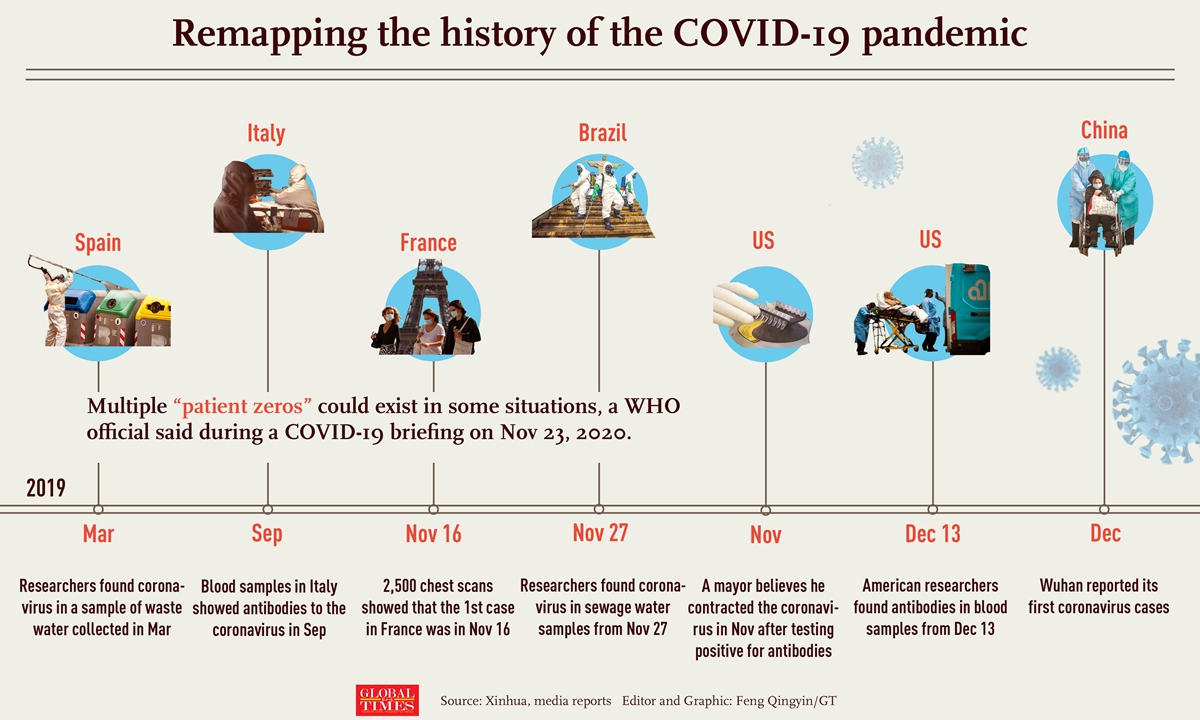WHO team to study virus jump to human
Global research needed on animals, elsewhere: Chinese virologist

A recent US CDC report found COVID-19 antibodies in blood samples as early as Dec 13, 2019. With more & more evidence surfacing about the coronavirus' origins in places outside China before Wuhan detected it, the world is remapping the history of the COVID-19 pandemic. Infographic:GT
The World Health Organization (WHO) has set up a 10-person international team on the global study of the origins of the novel coronavirus to visit China soon to investigate what one team member said was "where the virus first jumped from animals to humans."
Chinese virologists welcome the team's prospective visit but said the team cannot pin their hopes on this visit to China, as the mystery of virus origins needs investigations in many countries and research on more animal species.
A WHO spokesperson did not reveal the exact date of the international team's China visit, but said the team will travel to China in due time and once results from initial studies are available.
The WHO told the Global Times in a statement on Wednesday that regular meetings are taking place between the international mission members and Chinese researchers.
A strong scientific team has been set by our Chinese counterparts on this matter, and we trust this collaboration will continue so the international team can be deployed very soon, the WHO said, noting that it's asking all countries to support such efforts by demonstrating openness and transparency for the sake of scientific collaboration on virus origins studies.
According to a Terms of References for the China part on global study of virus origin sent to the Global Times by the WHO on Wednesday, the international team will conduct studies to better understand how the virus might have started circulating in Wuhan, and these studies include in-depth reviews of hospital records for cases compatible with COVID-19 before December 2019, and a mapping of activities and items traded at the Huanan seafood market and potentially other relevant markets in late November and December 2019, including types of animals and stalls present at the Huanan market, according to the WHO.
"The framework and methodological approaches implemented in China could also be used to study the virus origins elsewhere, if warranted," the WHO said.
Countries including the US, Italy and France have reported coronavirus evidence in environmental and human specimens before or around the time the virus was officially identified in China, and Chinese analysts have called on countries including Italy and the US to work with WHO to analyze and investigate the origin of the virus.
Fabian Leendertz, who is part of the WHO team to investigate the origins of the coronavirus and a biologist at Germany's Robert Koch Institute, said the team has already begun discussions with Chinese scientists and expect to travel to Wuhan next month, AP reported on Tuesday.
The WHO's international team plans to sift through samples and medical data from China to help determine where the virus first jumped from animals to humans and which species it came from, Leendertz said, noting that it's not about finding a guilty country, but trying to understand what happened and to reduce the risk in the future.
However, Yang Zhanqiu, deputy director of the pathogen biology department at Wuhan University, believes that hunting for virus origins in China may not be the ideal goal for the visit of the WHO international experts because multiple evidence shows the novel coronavirus could have started in many other countries before Wuhan reported its first case on December 8, 2019.
Yang told the Global Times that those experts cannot pin their hopes on how the virus jumped from animals to humans and which species it came from through this visit to China. There are many unanswered scientific questions, which cannot be solved by China alone but the entire international community.
All known evidence indicates that the novel coronavirus came from an animal, such as bats, but Yang said due to limited research globally on bats and other animals, the mystery of the origins has not been solved.
"Bats were considered as a potential culprit simply because there is academic and scientific research on bats from the Wuhan Institute of Virology with the Chinese Academy of Sciences, a field that other international scientists are barely involved in. What other animals should be included in this virus origin hunt? Are there animals that we missed, because no scientists have dug into them?" Yang said.
The WHO has conducted animal susceptibility studies in several countries, which showed that domestic cats, ferrets, hamsters and minks are particularly susceptible to infection, but when and where coronavirus spilled over to humans, and from which animal, remains unknown.
Yang raised several unanswered questions: animals such as bats have been working in harmony with human beings for decades, but how could they spread a virus to humans at the very exact time in 2019, and where are those animals?
"They may not just live in China but in Africa, the Americas or Europe. Is it possible that some animals in places such as the US where natural ecological environment are well-protected have some relation to the novel coronavirus as well?" Yang said.
The visit of WHO experts should also highlight sharing the Chinese experience on controlling the pandemic in a timely manner. This is a more realistic mission to complete, Yang said.





